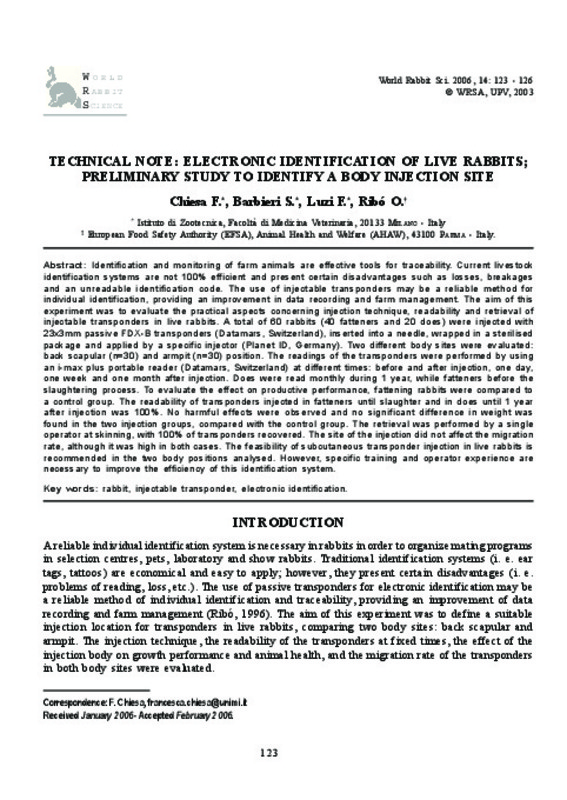JavaScript is disabled for your browser. Some features of this site may not work without it.
Buscar en RiuNet
Listar
Mi cuenta
Estadísticas
Ayuda RiuNet
Admin. UPV
Technical note: electronic identification of live rabbits ,preliminary study to identify a body injection site
Mostrar el registro sencillo del ítem
Ficheros en el ítem
| dc.contributor.author | Chiesa, F.
|
|
| dc.contributor.author | Barbieri, S.
|
|
| dc.contributor.author | Luzi, F.
|
|
| dc.contributor.author | Ribó, O.
|
|
| dc.date.accessioned | 2011-02-11T10:10:09Z | |
| dc.date.available | 2011-02-11T10:10:09Z | |
| dc.date.issued | 2006 | |
| dc.identifier.issn | 1257-5011 | |
| dc.identifier.uri | http://hdl.handle.net/10251/9666 | |
| dc.description.abstract | [EN] Identification and monitoring of farm animals are effective tools for traceability. Current livestock identification systems are not 100% efficient and present certain disadvantages such as losses, breakages and an unreadable identification code. The use of injectable transponders may be a reliable method for individual identification, providing an improvement in data recording and farm management. The aim of this experiment was to evaluate the practical aspects concerning injection technique, readability and retrieval of injectable transponders in live rabbits. A total of 60 rabbits (40 fatteners and 20 does) were injected with 23x3mm passive FDX-B transponders (Datamars, Switzerland), inserted into a needle, wrapped in a sterilised package and applied by a specific injector (Planet ID, Germany). Two different body sites were evaluated: back scapular (n=30) and armpit (n=30) position. The readings of the transponders were performed by using an i-max plus portable reader (Datamars, Switzerland) at different times: before and after injection, one day, one week and one month after injection. Does were read monthly during 1 year, while fatteners before the slaughtering process. To evaluate the effect on productive performance, fattening rabbits were compared to a control group. The readability of transponders injected in fatteners until slaughter and in does until 1 year after injection was 100%. No harmful effects were observed and no significant difference in weight was found in the two injection groups, compared with the control group. The retrieval was performed by a single operator at skinning, with 100% of transponders recovered. The site of the injection did not affect the migration rate, although it was high in both cases. The feasibility of subcutaneous transponder injection in live rabbits is recommended in the two body positions analysed. However, specific training and operator experience are necessary to improve the efficiency of this identification system. | es_ES |
| dc.description.sponsorship | This work was supported by FIRST 2003, Med. Vet. Fac., University of Milan. | |
| dc.language | Inglés | es_ES |
| dc.publisher | World Rabbit Science. ICTA. UPV | es_ES |
| dc.relation.ispartof | World Rabbit Science | |
| dc.rights | Reserva de todos los derechos | es_ES |
| dc.subject | Rabbit | es_ES |
| dc.subject | Injectable transponder | es_ES |
| dc.subject | Electronic identification | es_ES |
| dc.title | Technical note: electronic identification of live rabbits ,preliminary study to identify a body injection site | es_ES |
| dc.type | Artículo | es_ES |
| dc.date.updated | 2011-02-11T08:36:16Z | |
| dc.identifier.doi | 10.4995/wrs.2006.548 | es_ES |
| dc.rights.accessRights | Abierto | es_ES |
| dc.description.bibliographicCitation | Chiesa, F.; Barbieri, S.; Luzi, F.; Ribó, O. (2006). Technical note: electronic identification of live rabbits ,preliminary study to identify a body injection site. World Rabbit Science. 14(2). https://doi.org/10.4995/wrs.2006.548 | es_ES |
| dc.description.accrualMethod | SWORD | es_ES |
| dc.relation.publisherversion | https://doi.org/10.4995/wrs.2006.548 | es_ES |
| dc.description.volume | 14 | |
| dc.description.issue | 2 | |
| dc.identifier.eissn | 1989-8886 | es_ES |
| dc.contributor.funder | Università degli Studi di Milano |








